Calculating the Life of Linear Roller Bearings
Understand, calculate, and retain the life of your linear roller bearings
There are advantages to each type of linear roller bearing, and each of our Cam Roller products have their own unique calculations for factoring in their longevity or life. The following explains basic bearing design and the tendencies between single- and double-row roller bearings. Once defined, we dive a bit deeper and discuss how to properly calculate the statistical probability of life for a range of linear roller bearing solutions. Additionally, we offer extended reading via a white paper titled The Facts About Roller Bearing Life Calculations. Finally, we offer some quick tips on how to minimize corrosion and maximize the longevity of your roller bearings.
Single- and double-row roller bearings in linear motion
Linear motion applications are often found to have both radial and axial load requirements. For this dual need in load applications, PBC Linear offers customers both single-row and double-row angular contact bearings. The main advantage of a single-row bearing is its slimmer profile. While they can be used in tighter applications, their narrower profile limits the number of balls inside, consequently reducing the amount of radial, axial and moment loads that the bearing can support. PBC Linear limits the use of its single row bearings to custom product applications where load is not the limiting factor, and a slimmer profile is critical.
Double-row bearings contain a thick outer ring which is often machined to match the corresponding raceway. These bearings provide a longer life, along with higher radial, axial, and moment load capabilities.
Figure 1 is a schematic of double row angular contact construction, and illustrates a typical double ball roller construction. Using the two examples below, we can illustrate the different ways in which double-rollers can contact the corresponding shaft. For example, in figure 2, a 90-degree V-roller profile matches up with a 90-degree raceway.
In this scenario, the V profile transfers the load from the roller to the rail via a single line segment contact. A line segment contact can be defined as a perfectly straight curve between two points which contains an infinite number of points.
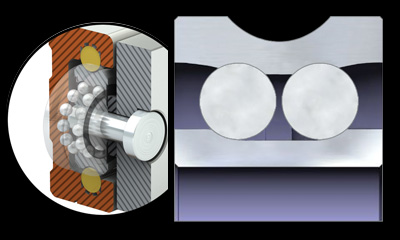
Figure 1
In figure 3, a Redi-Rail Gothic arch profile matches up with round shafting, and utilizes a double-row angular contact construction inside. The Illustration shows how the outer race of the cam roller and the track upon which it rides meet at two points along what is typically a linear shaft. We can see that the load is transferred between the roller and the race via these two very small points of contact. Gothic arch designs offer the ability to withstand loads from any direction and have relatively high moment load capacities. Accordingly, bearings that use only two rows of recirculating balls (one row on each side of the bearing), will typically have a Gothic arch arrangement.
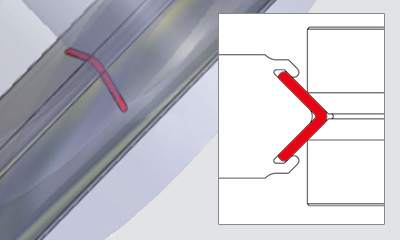
Figure 2
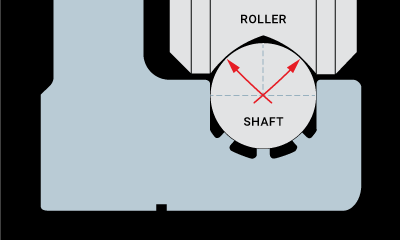
Figure 3
Shaft Hardness and Linear Bearing Life
Bearing life is usually expressed as the number of hours an individual bearing will operate before the first evidence of metal fatigue develops. The usual life rating for industrial applications is called “L-10” life. The L-10 life is the number of hours in service that 90% of the bearings will survive.
The service life of a rolling element linear bearing can be affected by many variables. One important factor to consider is the shaft or running surface hardness. Here is an explanation and calculation for how bearing life can vary with shaft hardness.
The optimal hardness for a round shaft, V-Guide rail, or other linear raceway that accompanies a steel rolling element bearing is Rc60. If hardness is below that number on the Rockwell scale, performance can be greatly affected. This is accounted for in the standard formula for calculating bearing life. Using the graph, the fH or hardness factor can first be determined and then plugged into the life formula to account for the softer shaft surface.
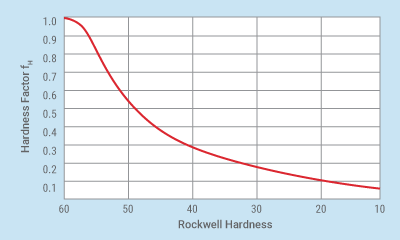
Below is the standard life formula for a rolling element linear bearing, where:
L = Rating life (km)
fH = Hardness factor
fT = Temperature coefficient
fC = Contact coefficient
fW = Load coefficient
C = Basic dynamic load rating (N)
P = Load (N)
Below are 3 examples of similar type rails with varying hardness measurements. When working through the life calculation formula, we consider only the hardness factor to change, leaving all other factors equal at a value of 1. We can observe the impact that the hardness factor has on bearing performance.
- 420 sst, hardened to Rc40 −> fH = 0.27
L = (0.27)3 x 50 = 0.98 km
- 440 sst, hardened to Rc50 −> fH = 0.53
L = (0.53)3 x 50 = 7.44 km
- 420 sst, hardened to Rc60 −> fH = 1.0
L = (1.00)3 x 50 = 50 km
Customers can avoid previous industry misconceptions and discover how to properly calculate the statistical probability of life for a range of linear roller bearing solutions.Our in-depth Roller Bearing Life Calculations white paper provides a detailed analytical approach to calculating life, and is designed to give engineers confidence when applying our broad range of linear motion solutions to their applications. This method applies to all products within the Cam Roller Technology (CRT) family including Redi-Rail, V-Guide wheel, Commercial Rail, and Hevi-Rail, along with Integral-V Technology (IVT).
All factors and formulas are based on data that has been proven over time by sources such as the International Organization for Standardization (ISO), as well as its membership bodies that include, but are not limited to, the American National Standards Institute (ANSI), Deutsches Institut für Normung (DIN), and the Japanese Industrial Standards Committee (JISC).
Minimize Corrosion and Maximize Life
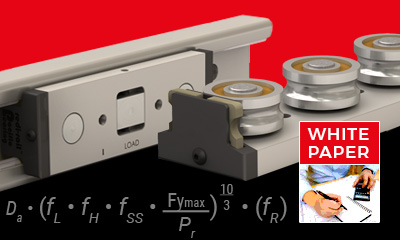
Fretting corrosion of a V-Guide wheel or other type of steel roller bearing within a linear motion system is a sign of improper or complete lack of lubrication. The main symptom to look for is a discoloration that appears as rust (Figure 4). This will most often be the first sign of fretting corrosion and can help to alert and eliminate premature failure in your linear motion system. This rust colored material is actually wear-debris that is breaking away from the steel races at a microscopic level. This damage to the contact surface becomes an abrasive asperity that increases the wear rate, impedes the effects of lubrication, and results in further fretting and breakdown of the system.
The solution to fretting corrosion requires proper lubrication at the initial installation of the raceways. Added lubricators can help to keep the necessary amount of lubrication on the raceways over time. When using a steel-on-steel bearing system, lubrication is the key ingredient that can make or break bearing service life.

Figure 4
Discover your ideal linear motion solution:






